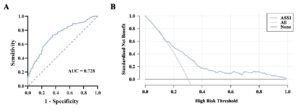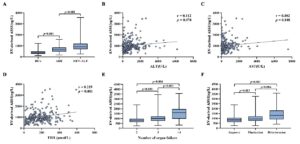Hepatitis E virus (HEV) infection is usually a self-limiting disease, and the majority of infections are asymptomatic. However, 5%-30% of HEV-infected patients present acute symptoms, and 0.5%-4% will develop acute liver failure (ALF), especially in pregnant women, the elderly or people with underlying liver diseases. In pregnant women, the risk of developing ALF increases to 15%-25%. Early diagnosis, effective treatment and active prevention of complications are essential in ALF patients, and accurate prediction of the ALF occurrence is conducive to prevention and early intervention. Nevertheless, specific predictive biomarkers for HEV-ALF have not been effectively studied. Hence, the development of biomarkers for predicting the HEV-ALF occurrence is of great significance.
A recent study, led by Prof. Jian Wu from Affiliated Suzhou Hospital of Nanjing Medical University, Dr. Ze Xiang from Zhejiang University, China, assessed the predictive ability of extracellular vesicle (EV)-derived argininosuccinate synthase 1 (ASS1) levels for HEV-ALF occurrence. The team collected serum samples from 250 HEV-ALF patients, 250 patients with acute hepatitis E (AHE) and 250 health controls (HCs). Serum EVs were successfully isolated. Serum EV-derived ASS1 levels in the HEV-ALF group was significantly higher than those in the AHE group, and serum EV-derived ASS1 levels in the AHE group were significantly higher than those in the HCs group (Figure 1A). The serum EV-derived ASS1 levels positively correlated with the levels of TBIL (Figure 1D), while neither significant difference between serum EV-derived ASS1 levels and ALT levels was discovered (Figure 1B), nor significant difference between serum EV-derived ASS1 levels and AST levels (Figure 1C). In HEV-ALF patients, serum EV-derived ASS1 levels were positively correlated with the number of failed organs and disease progression (Figure 1E, F).
Figure 1 Relationship between serum EV-derived ASS1 levels and dynamic changes in HEV-ALF patients. (A) The levels of serum EV-derived ASS1 in the HCs, AHE and HEV-ALF groups; (B-D) The correlation between serum EV-derived ASS1 levels and HEV-related parameters, including ALT, AST and TBIL; (E) The levels of serum EV-derived ASS1 in the number 2, number 3 and number >3 groups; (F) The levels of serum EV-derived ASS1 in the improvement, fluctuation and deterioration groups.
The logistical regression showed that serum EV-derived ASS1 level is an independent risk factor for HEV-ALF, and orthogonal partial least squares discriminant analysis also suggested that serum EV-derived ASS1 level has high predictive capability. Besides, the area under the curve of serum EV-derived ASS1 level to predict HEV-ALF occurrence was 0.728 (0.684-0.772) with the sensitivity and specificity being 72.80% and 64.80% (Figure 2A), and decision curve analysis results showed that the levels of serum EV-derived ASS1 had a high decision-making ability (Figure 2B). Furthermore, there existed no significant difference between the age ≥60 and age <60 groups in serum EV-derived ASS1 levels.

Figure 2 Prediction ability of serum EV-derived ASS1 levels for HEV-ALF occurrence. (A) Receiver operating characteristic curve analysis of serum EV-derived ASS1 levels to predict the HEV-ALF occurrence; (B) Evaluation of the benefit of serum EV-derived ASS1 levels in assisting decision-making at different threshold probabilities using decision curve analysis
In summary, serum extracellular vesicle-derived ASS1 is a promising predictor for the occurrence of HEV-ALF, which may provide new insights into the prediction of HEV-ALF.
Read the full article (J Med Virol. 2022 Dec 23. doi: 10.1002/jmv.28425. Online ahead of print): https://onlinelibrary.wiley.com/doi/10.1002/jmv.28425.


